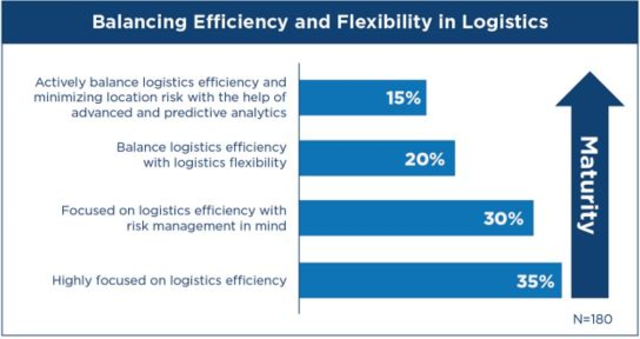
Numerous supply chain disruptions, from supplier outages to geopolitical conflict, natural disasters, global pandemics, and more, have provided organizations with opportunities to learn and mature their approach to risk. While risks will always be present in the supply chain, leading organizations are able to plan for these risks and minimize their impact by balancing tradeoffs between efficiency and flexibility in logistics.
“Just in time” approaches to inventory might make sense in a perfect world but are increasingly unsuitable for a business environment where disruption is the norm. Many customers will quickly lose patience when their orders are stuck at the Suez Canal or delayed indefinitely because your only supplier just closed their manufacturing site. By finding an ideal balance between “just in time” and “just in case,” leading organizations can plan for disruption while also minimizing the risk of excess or obsolete inventory. Unfortunately, few organizations have been able achieve this level of supply chain resilience.
Despite repeated opportunities to learn from disruption, it is disappointing to see how many organizations remain entirely focused on efficiency in logistics. For example, through a recent survey of supply chain professionals, APQC found that more than a third of respondents (35%) say that their supply chain organization is highly focused on efficiency. Another 30% say that they are focused on logistics efficiency with risk management in mind. Put another way, about two-thirds of respondents are not taking any meaningful action to balance logistics efficiency with logistics flexibility (Figure 1).
 APQC Fig. 1
APQC Fig. 1
Structure Your Operations for Resiliency
While about two-thirds of respondents are focusing on efficiency (and are thus more vulnerable to disruption), about another third of respondents (35%) are actively working to balance logistics efficiency with logistics flexibility. To reduce their exposure to risk and structure their operations for resiliency, these organizations are carrying out practices like:
- increasing supply redundancy,
- designing supply chains to reduce single points of failure,
- shortening supply chains through strategies like nearshoring, and
- allocating critical materials and products to multiple locations to meet customer service levels while minimizing inventory and storage levels.
By integrating resilience considerations into short-term sales and operations execution as well as longer-term sales and operations planning, organizations are better equipped to balance cost, risk, and working capital.
Organizations at the highest level of maturity (15% of all respondents) make an even greater effort to build resiliency by leveraging predictive analytics to minimize location risks. Tools available on the market today can help organizations to map suppliers (down to the second or even third tier), map the flow of goods according to their mode of transport, and use this data to assess and mitigate any supply chain bottlenecks. These tools can also send alerts when a supplier disruption is likely to occur, giving organizations more time to plan, respond and get the business back on track more quickly.
Key Takeaways
Organizations’ exposure to risk has grown exponentially as the world has become more integrated and supply chains have become increasingly complex. Organizations that care about their long-term survival and profitability need to assume that disruptions will inevitably occur and build supply chains that can flex and adapt in the face of these disruptions. Given that so few organizations are building these types of supply chains, the ones that do are going to be able to outmaneuver their competitors when risk becomes reality.




















